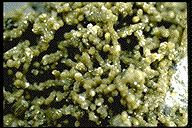 THE MINERAL OTAVITE
THE MINERAL OTAVITE
- Chemistry: CdCO3, Cadmium Carbonate.
- Class: Carbonate.
- Group: Calcite.
- Uses: A minor ore of cadmium and as mineral specimens.
- Specimens
Otavite is a rare mineral from the famous mines of
Tsumeb,
Otavi (hence the name), Namibia.
It is one of only a few cadmium minerals as cadmium is usually a trace element in other minerals.
Other cadmium minerals include:
Native
elemental cadmium;
the
oxide mineral
monteponite;
the
sulfide minerals
greenockite,
hawleyite,
cadmoselite,
shadlunite,
barquillite,
cernyite and
quadratite;
the
sulfate mineral
niedermayrite,
and the
arsenate minerals
andyrobertsite,
and
keyite.
All are rare minerals, as is otavite.
Otavite is a member of the
Calcite Group of minerals.
Most other members of this group are quite common and include such well known minerals as
calcite,
siderite,
rhodochrosite,
smithsonite and
magnesite.
PHYSICAL CHARACTERISTICS:
- Color is usually white, but can also be yellowish brown, reddish brown and brown.
- Luster is adamantine to pearly.
- Transparency crystals are usually translucent to transparent.
- Crystal System is trigonal; bar 3 2/m.
- Crystal Habits are limited to crusts and tiny scalahedral crystals.
- Cleavage is perfect in 3 non-perpendicular directions forming rhombs.
- Fracture is conchoidal.
- Hardness is 3.5 - 4.
- Specific Gravity is 5 (very heavy for a translucent mineral).
- Streak is white.
- Other Characteristics: Effervesces with acid and some specimens have fluoresced red under shortwave UV light.
- Associated Minerals includes
azurite,
malachite,
smithsonite and
calcite.
- Notable Occurrences include the type locality of
Tsumeb,
Otavi (hence the name), Namibia; Blanchard Mine, New Mexico, USA and Broken Hill, New South Wales, Australia.
- Best Field Indicators are density, reaction to acids, cleavage, color and locality.










